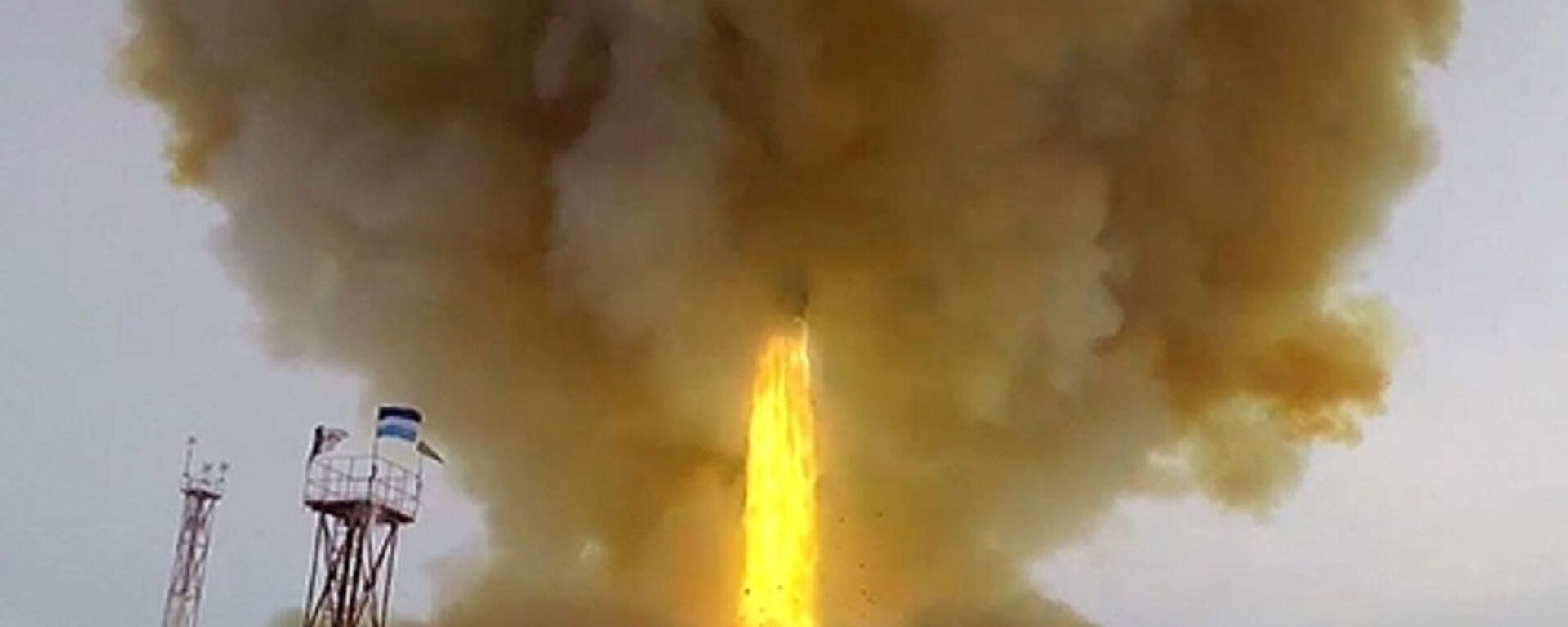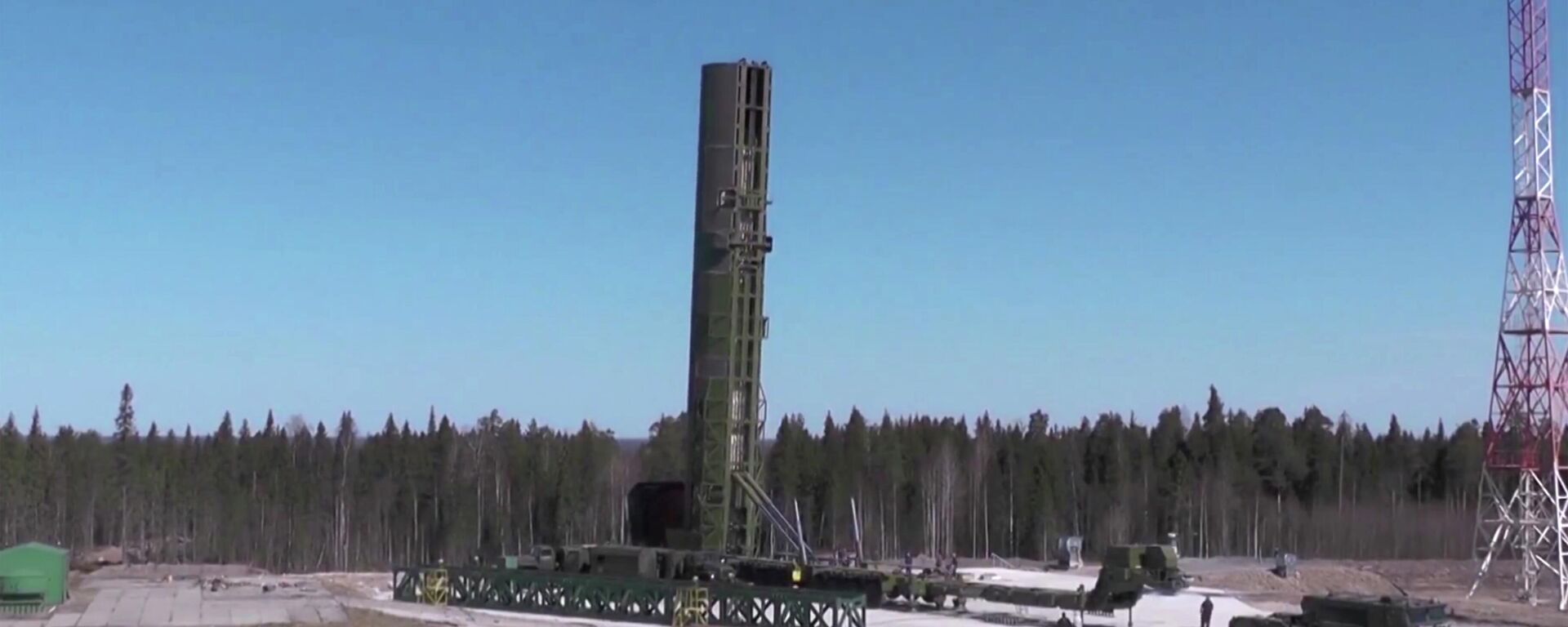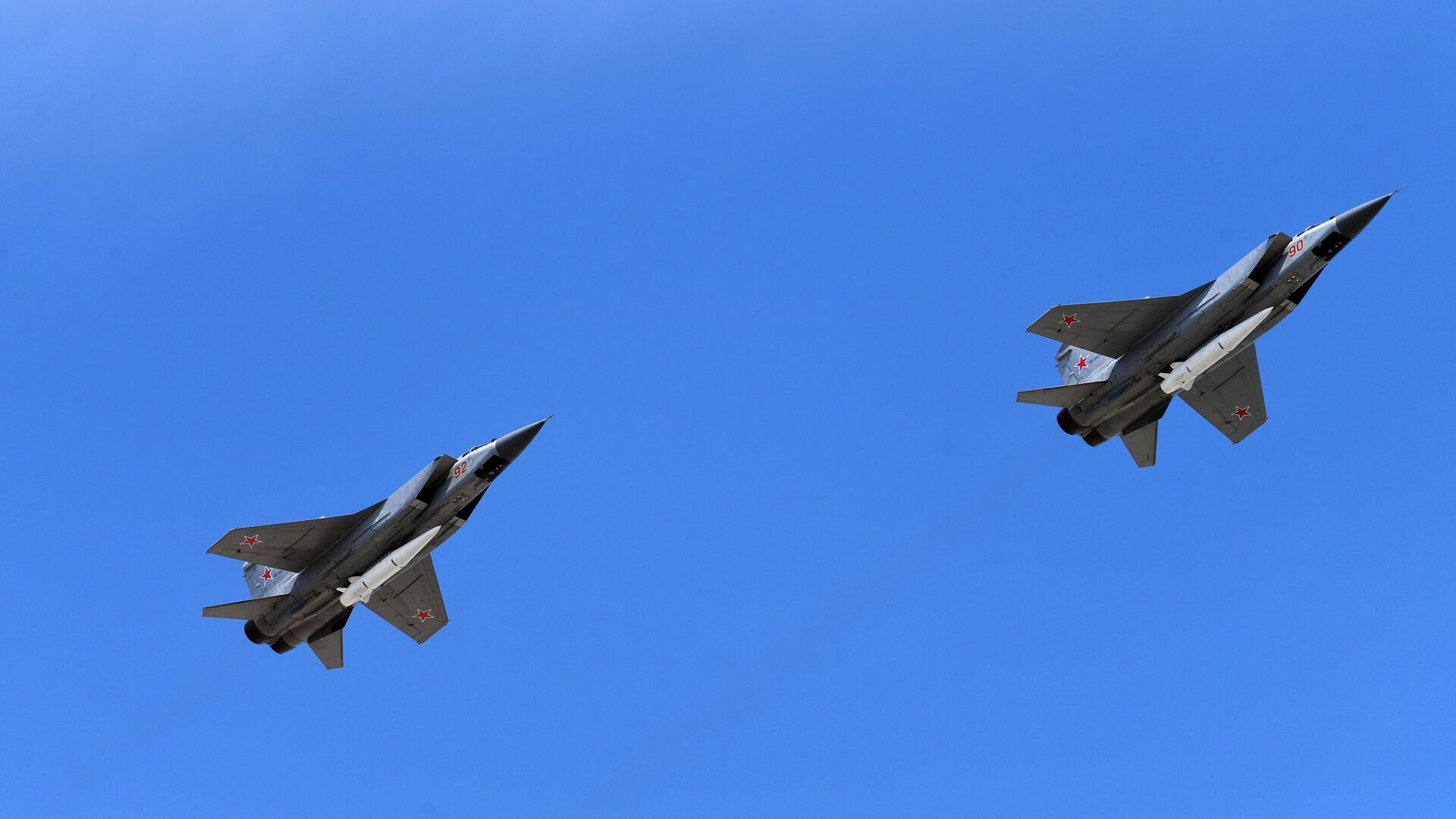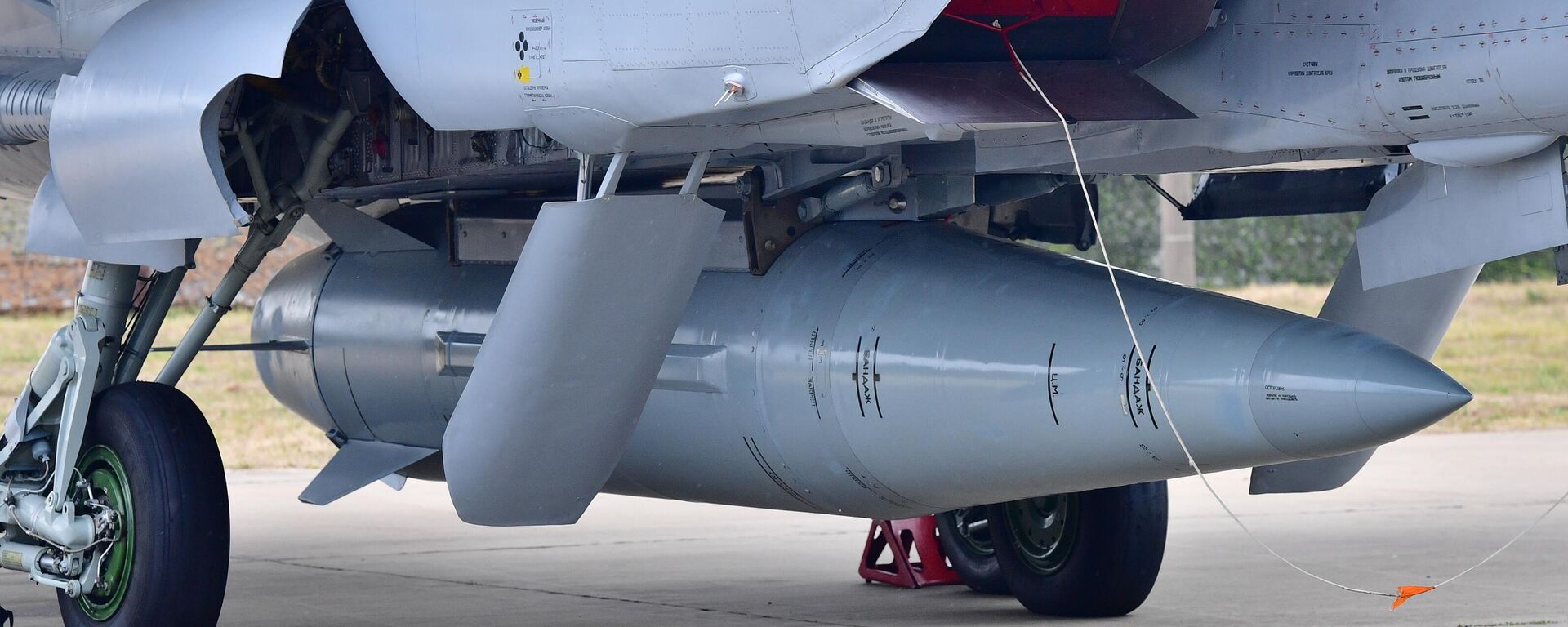https://sputnikglobe.com/20230512/from-avangard-to-zircon-how-far-do-russian-missiles-fly-1110296500.html
From Avangard to Zircon: How Far Do Russian Missiles Fly?
From Avangard to Zircon: How Far Do Russian Missiles Fly?
Sputnik International
The Russian and US militaries got into a shouting match this week after the Pentagon claimed a Patriot missile deployed in Ukraine shot down a Kinzhal missile. What are the capabilities of the Kinzhal and other major missile systems in Russia’s arsenal? Sputnik takes a look.
2023-05-12T17:11+0000
2023-05-12T17:11+0000
2023-05-12T18:45+0000
military
vladimir putin
mikhail gorbachev
russia
ukraine
west
pentagon
bulava
patriot
sarmat
https://cdn1.img.sputnikglobe.com/img/106427/97/1064279779_0:320:3072:2048_1920x0_80_0_0_7102ded646a96854686b105f830d86a7.jpg
A high-ranking source in Russia’s Defense Ministry mopped the floor with Pentagon claims about a Patriot missile shooting down a Russian Kinzhal, telling reporters Thursday that the Russian missile’s flight speed exceeds the capabilities of all anti-aircraft missile systems supplied by the West to Kiev to intercept it, "including the Patriot."The explanation challenges assertions made by Pentagon Press Secretary Pat Ryder Tuesday "confirm[ing] that [Ukraine] did down" a Kinzhal using a US-supplied Patriot. The shootdown claim goes back more than a week and originates from a Telegram post by Ukrainian Air Force commander Mykola Oleshchuk on May 6 that a Patriot downed a Kinzhal during a night raid over the Kiev region on May 4."We will be certain to report what, where, with what and when [missiles] are shot down! All in good time," Oleshchuk promised.What is the Kinzhal?The Kinzhal (lit. "Dagger") is one of half-a-dozen new strategic weapons unveiled by Russian President Vladimir Putin in a speech to lawmakers in March 2018. First entering combat duty in December 2017, and seeing extensive flight and combat testing, the nuclear-capable weapon was the first hypersonic missile system to be fielded by any country.Carried by modified MiG-31 jets, Tupolev Tu-22, or Tu-160 strategic bombers, Kinzhals have an operational speed of Mach 10-13 (11,200-14,500 feet/second), and an operational range of up to 2,000 km when launched from MiG-31Ks, or over 3,000 km when launched from Tu-22M3s. Fitted with an inertial navigation system, GLONASS, AWACS, and/or optical seeker to guide the missile to its target, the Kinzhal carries a 500 kg high explosive warhead, or, in nuclear mode, a 5-50 kiloton payload.Russia has used Kinzhals extensively in the proxy war with NATO in Ukraine, targeting ammunition and fuel depots, ports, and – after last fall’s attack on the Crimean Bridge, Ukrainian energy infrastructure. The missile's 2,000 km range is sufficient to strike anywhere in the country. It is the only one of Russia's new generation of strategic weapons to be used in Ukraine.What are Russia’s Other Modern Strategic WeaponsWhat is the Avangard?The Avangard (lit. "Vanguard") is another of the advanced weapons platforms unveiled by Putin in his 2018 speech. The Avangard is a hypersonic glide vehicle carried on board R-36 or RS-28 Sarmat intercontinental ballistic missiles (ICBMs) as part of multiple reentry vehicle (MIRV) payloads. In service with the Strategic Rocket Forces since 2018, the nuclear-capable glide vehicles have a reported range of over 6,000 km, and an explosive power of between 0.8 and 2 megatons when armed with a nuclear payload. Combined with the range of their ICBM carriers, Avangards have what is effectively a global reach.What is the Bulava?The Bulava is a solid-fuel submarine-launched ballistic missile (SLBM) with a range of up to 10,000 km. Introduced in the Navy in 2018, the Bulava is a replacement to the R-39 – which has a range of 8,300 km. Bulavas are capable of carrying between six and ten 100-150 kiloton MIRVs, which accelerate to speeds of up to Mach 24 (28,600+ km/hour) during flight. The missiles are carried by Borei and Borei-A subs. Typically, these subs lurk below the surface of the seas near Russia’s Arctic and Pacific Ocean coasts, making their detection virtually impossible until launch. Bulavas maneuver in the boost stage, theoretically making it impossible for them to be intercepted by any current-generation anti-ballistic missile system.What is the Sarmat?The RS-28 Sarmat is the newest missile in Russia’s strategic arsenal, with the first missiles expected to join the Strategic Nuclear Forces in the current year. With a globe-spanning range of 18,000 km and a maximum speed of up to 25,500 kilometers per hour (about Mach 20), the silo or mobile carrier-launched missiles can carry up to 10 traditional MIRV warheads, a mix of MIRVs and Avangards, or a mix of MIRVs, Avangards, and decoys. The Sarmat is set to be the backbone of Russia's ground-based strategic deterrent. The regular warheads maneuver in depth as they approach targets, making them almost impossible to intercept.What is the Zircon?Last but not least is the Zircon – a scramjet-powered maneuvering hypersonic cruise missile designed specifically to target enemy ships, but which is also capable of engaging ground targets. The solid-fuel missiles – carried by launch platforms from surface warships to submarines, have a maximum firing range of between 400 and 1,000 km – well beyond standoff range. First introduced into service in January 2023, the Zircon is capable of accelerating to speeds up to Mach 9 (over 11,100 km per hour) during approach – nearly 11 times higher than the Tomahawk. Zircons are nuclear-capable, featuring a 300-400 kg warhead and, in nuclear mode, a throw weight of up to 200 kilotons.Why Does Russia Have So Many Different Types of Modern Missiles?Moscow began experimenting with hypersonic missile designs in the 1980s, but dramatically scaled back the development effort in the 1990s after the collapse of the Soviet Union and attempts to gain the trust and respect of Washington and what Soviet President Mikhail Gorbachev referred to as the so-called "civilized community of nations." Russia dusted off these Soviet blueprints, and expanded on them to create entirely new designs, in the early 2000s, when the United States unilaterally scrapped the Anti-Ballistic Missile Treaty of 1972 and began working on new missile defenses, as well as "Prompt Global Strike" – an ambitious plan to engage in mass conventional missile-based decapitation strikes designed to destroy the strategic deterrent of enemy nations.In other words, had the US observed the post-Cold War aspirations of Russia to partner with and cooperate with the West instead of deliberately antagonizing and threatening it at every step, Moscow probably would have never embarked on the path of developing its strategic potential to the level it’s at today.
https://sputnikglobe.com/20230510/fact-check-ukraine-didnt-shoot-down-russias-kinzhal-hypersonic-missile-1110235332.html
https://sputnikglobe.com/20200923/eskimo-effect-putin-explains-avangard-hypersonic-glide-vehicles-operating-principle-1080552063.html
https://sputnikglobe.com/20201212/video-shows-russian-borei-class-sub-vladimir-monomakh-conducts-battery-launch-of-4-bulava-missiles-1081439497.html
https://sputnikglobe.com/20220922/russias-sarmat-icbm-can-correct-trajectory-even-if-hit-by-enemy-missile-defense-designer-says-1101087476.html
https://sputnikglobe.com/20230125/russian-frigate-admiral-gorshkov-test-fires-zircon-missile-in-atlantic-1106674775.html
https://sputnikglobe.com/20200919/putin-russia-was-forced-to-create-hypersonic-weapons-after-us-withdrew-from-missile-treaty-1080513306.html
russia
ukraine
west
Sputnik International
feedback@sputniknews.com
+74956456601
MIA „Rossiya Segodnya“
2023
News
en_EN
Sputnik International
feedback@sputniknews.com
+74956456601
MIA „Rossiya Segodnya“
Sputnik International
feedback@sputniknews.com
+74956456601
MIA „Rossiya Segodnya“
russian missiles, avangard, kinzhal, sarmat, zircon, bulava, range, throw weight, armament, weapons, strategic missile, russia, united states, ukraine, capabilities, rs-28 sarmat, kh-47m2 kinzhal, 3m22 zircon, avangard, hypersonic glide vehicle, avangard hypersonic glide vehicle, can russian missiles reach the uk, russian hypersonic missiles, russian hypersonic missiles speed, russian hypersonic missiles in ukraine, russian hypersonic missiles list, 3m22 zircon missile, 3m22 zircon hypersonic, 3m22 zircon hypersonic anti-ship missile, 3m22 zircon cost, 3m22 zircon price, 3m22 zircon speed, zircon hypersonic missile, zircon missile, zircon, kinzhal missile, kinzhal, kinzhal hypersonic missile, rs-28 sarmat, rs-28 sarmat missile, rs-28 sarmat speed, avangard missile speed, avangard missile range
russian missiles, avangard, kinzhal, sarmat, zircon, bulava, range, throw weight, armament, weapons, strategic missile, russia, united states, ukraine, capabilities, rs-28 sarmat, kh-47m2 kinzhal, 3m22 zircon, avangard, hypersonic glide vehicle, avangard hypersonic glide vehicle, can russian missiles reach the uk, russian hypersonic missiles, russian hypersonic missiles speed, russian hypersonic missiles in ukraine, russian hypersonic missiles list, 3m22 zircon missile, 3m22 zircon hypersonic, 3m22 zircon hypersonic anti-ship missile, 3m22 zircon cost, 3m22 zircon price, 3m22 zircon speed, zircon hypersonic missile, zircon missile, zircon, kinzhal missile, kinzhal, kinzhal hypersonic missile, rs-28 sarmat, rs-28 sarmat missile, rs-28 sarmat speed, avangard missile speed, avangard missile range
A high-ranking source in Russia’s Defense Ministry mopped the floor with Pentagon claims about a Patriot missile shooting down a Russian Kinzhal, telling reporters Thursday that the Russian missile’s flight speed exceeds the capabilities of all anti-aircraft missile systems supplied by the West to Kiev to intercept it, "including the Patriot."
"The anti-missile maneuver carried out by the Kinzhal in the final flight segment and the almost vertical approach to the target makes it impossible for anti-aircraft missile systems to intercept this weapon," the source
said.
The explanation challenges
assertions made by Pentagon Press Secretary Pat Ryder Tuesday "confirm[ing] that [Ukraine] did down" a Kinzhal using a US-supplied Patriot. The shootdown claim goes back more than a week and originates from a
Telegram post by Ukrainian Air Force commander Mykola Oleshchuk on May 6 that a Patriot downed a Kinzhal during a night raid over the Kiev region on May 4.
"We will be certain to report what, where, with what and when [missiles] are shot down! All in good time," Oleshchuk promised.
It's been more than a week, and Ukraine has yet to provide any independently verifiable evidence. Instead, Kiev Mayor Vitaly Klitschko posed with German media in front of a "Kinzhal warhead" that looks nothing like the Kinzhal, with the tired-looking warhead featuring what appears to be moss growing out of it and slowly rusting.
The Kinzhal (lit. "Dagger") is one of half-a-dozen new strategic weapons unveiled by Russian President Vladimir Putin in a speech to lawmakers in March 2018. First entering combat duty in December 2017, and seeing extensive flight and combat testing, the nuclear-capable weapon was the first hypersonic missile system to be fielded by any country.
Carried by modified MiG-31 jets, Tupolev Tu-22, or Tu-160 strategic bombers, Kinzhals have an operational speed of Mach 10-13 (11,200-14,500 feet/second), and an operational range of up to 2,000 km when launched from MiG-31Ks, or over 3,000 km when launched from Tu-22M3s. Fitted with an inertial navigation system, GLONASS, AWACS, and/or optical seeker to guide the missile to its target, the Kinzhal carries a 500 kg high explosive warhead, or, in nuclear mode, a 5-50 kiloton payload.
Russia has used Kinzhals extensively in the proxy war with NATO in Ukraine, targeting ammunition and fuel depots, ports, and – after last fall’s attack on the Crimean Bridge, Ukrainian energy infrastructure. The missile's 2,000 km range is sufficient to strike anywhere in the country. It is the only one of Russia's new generation of strategic weapons to be used in Ukraine.
What are Russia’s Other Modern Strategic Weapons
The Avangard (lit. "Vanguard") is another of the advanced weapons platforms unveiled by Putin in his 2018 speech. The Avangard is a hypersonic glide vehicle carried on board R-36 or RS-28 Sarmat intercontinental ballistic missiles (ICBMs) as part of multiple reentry vehicle (MIRV) payloads. In service with the Strategic Rocket Forces
since 2018, the nuclear-capable glide vehicles have a reported range of over 6,000 km, and an explosive power of between 0.8 and 2 megatons when armed with a nuclear payload. Combined with the range of their ICBM carriers, Avangards have what is effectively a global reach.

23 September 2020, 17:01 GMT
The Bulava is a solid-fuel submarine-launched ballistic missile (SLBM) with a range of up to 10,000 km. Introduced in the Navy in 2018, the Bulava is a replacement to the R-39 – which has a range of 8,300 km. Bulavas are capable of carrying between six and ten 100-150 kiloton MIRVs, which accelerate to speeds of up to Mach 24 (28,600+ km/hour) during flight. The missiles are carried by Borei and Borei-A subs. Typically, these subs lurk below the surface of the seas near Russia’s Arctic and Pacific Ocean coasts, making their detection virtually impossible until launch. Bulavas maneuver in the boost stage, theoretically making it impossible for them to be intercepted by any current-generation anti-ballistic missile system.

12 December 2020, 15:49 GMT
The RS-28 Sarmat is the newest missile in Russia’s strategic arsenal, with the first missiles expected to join the Strategic Nuclear Forces in the current year. With a globe-spanning range of 18,000 km and a maximum speed of up to 25,500 kilometers per hour (about Mach 20), the silo or mobile carrier-launched missiles can carry up to 10 traditional MIRV warheads, a mix of MIRVs and Avangards, or a mix of MIRVs, Avangards, and decoys. The Sarmat is set to be the backbone of Russia's ground-based strategic deterrent. The regular warheads maneuver in depth as they approach targets, making them almost impossible to intercept.

22 September 2022, 12:55 GMT
Last but not least is the Zircon – a scramjet-powered maneuvering hypersonic cruise missile designed specifically to target enemy ships, but which is also capable of engaging ground targets. The solid-fuel missiles – carried by launch platforms from surface warships to submarines, have a maximum firing range of between 400 and 1,000 km – well beyond standoff range. First introduced into service in January 2023, the Zircon is capable of accelerating to speeds up to Mach 9 (over 11,100 km per hour) during approach – nearly 11 times higher than the Tomahawk. Zircons are nuclear-capable, featuring a 300-400 kg warhead and, in nuclear mode, a throw weight of up to 200 kilotons.

25 January 2023, 06:23 GMT
Why Does Russia Have So Many Different Types of Modern Missiles?
Moscow began experimenting with hypersonic missile designs in the 1980s, but dramatically scaled back the development effort in the 1990s after the collapse of the Soviet Union and attempts to gain the trust and respect of Washington and what Soviet President Mikhail Gorbachev referred to as the so-called "civilized community of nations." Russia dusted off these Soviet blueprints, and expanded on them to create entirely new designs, in the early 2000s, when the United States
unilaterally scrapped the Anti-Ballistic Missile Treaty of 1972 and began working on new missile defenses, as well as "Prompt Global Strike" – an ambitious plan to engage in mass conventional missile-based decapitation strikes designed to destroy the strategic deterrent of enemy nations.
"America’s withdrawal from the ABM Treaty in 2002 forced Russia to start developing hypersonic weapons," President Putin recalled in a conversation with legendary Soviet and Russian rocket designer Gerbert Efremov in 2020.

19 September 2020, 11:16 GMT
"We had to create these weapons in response to the deployment of the US strategic missile defense system, which would have been able to neutralize and render obsolete our entire nuclear potential,” Putin said. Today, the Russian president explained, “for the first time in modern Russia’s history, the country possesses the most modern types of weapons, which are far superior in terms of their force, power, speed, and very importantly, in terms of accuracy compared to all which existed before them and exist today."
In other words, had the US observed the post-Cold War aspirations of Russia to partner with and cooperate with the West instead of deliberately antagonizing and threatening it at every step, Moscow probably would have never embarked on the path of developing its strategic potential to the level it’s at today.








